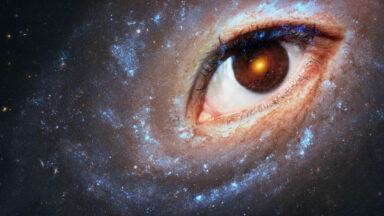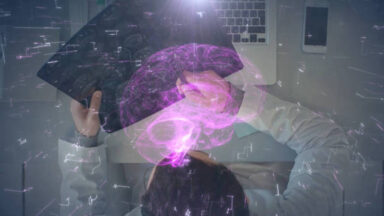Philip K. Dick’s Communication with Valis and the Evolution of Humanity

Valis, Philip K. Dick, and the Evolution of Humanity
When Philip K. Dick went to the dentist in February 1974, the acclaimed science fiction author did not know that his view of reality was about to change. He was in a lot of pain with what turned out to be an impacted wisdom tooth, and was sedated with sodium pentothal while the dentist removed the tooth. The pain afterwards was fairly severe, so the dentist ordered a painkiller, Darvon, for delivery to his patient’s home later that day.
When the courier arrived, Dick answered the door and was suddenly taken aback by a pendant she was wearing. It was a fish ornament, which she explained Christians adopted as a symbol of their religion. He saw a “red and gold plasmic entity” coming from the pendant and, as he reported it, immediately experienced “crystal clear” vision and “sudden exposure to a vast amount of knowledge.”
This was not his first experience with visions and hearing voices. The voice he heard was the same voice he had heard years before while in college. He also began channeling an alien presence he called “Vast Active Living Intelligence System,” or “Valis” for short. The intense visions lasted for two months, leading him to refer to this period of his life as “2-3-74,” for February and March 1974. During the next eight years, he wrote thousands of pages about his visions and voices. His novels were more autobiographical than they were science fiction.
Dick died suddenly in 1982, shortly before the release of the movie “Blade Runner” based on Dick’s book, “Do Androids Dream of Electric Sheep?” Many of his other books are now movies, as well. He is now known as the “most influential writer of science fiction in the past half century.”
But, was it all science fiction? He received multiple communications from Valis, had dreams and visions about the future, and spent the rest of his life trying to understand why he gained such supreme knowledge. He claimed to have “total recall of the future.”
Philip K. Dick: The Pre-Valis Years
Philip Kindred Dick was born in December 1928 during the cold Chicago winter. He had a twin sister, Jane, who lived for only about eight weeks. She died mysteriously, some saying she had an allergy to her mother’s breast milk. Whatever happened, Dick went through his life always missing his sister and blaming his mother for her death. His father left the family when he was only 5 years old. Shortly after that, he and his mother moved to Berkeley, California, where he lived most of his life.
First published when he was just a teenager, his first short story marked the beginning of a prolific writing career. Although he successfully published a number of his stories, he was not such a success financially. He was always running out of money and seemed to live from advance to advance.
Dick’s life was not emotionally easy and he seemed troubled throughout his entire life: married five times with three children, thought to use drugs and experiment with LSD, and frequent visions of his own death. Despite drug use allegations, he was able to continue writing. By the time of his death, he had published more than 120 short stories and 44 novels.
As early as 1954, Dick wrote about precognition in his novel, “The World Jones Made.” Based on his own experiences, the main character in that book was a “precog” who could see one year into the future. His books often referenced precognition, and Dick believed he himself had this ability.
He also heard voices, or at least a voice. As a young man taking the physics portion of a college entrance exam, Dick found that he did not understand eight of the 10 questions. Suddenly, he heard the voice explain to him, in a completely understandable way, what he needed to know. As a result, he received a perfect score on the test.
He heard the same voice again years later, when it explained to him what was happening in a television documentary that he had had difficulty understanding. In 1974, the same voice returned when he had his life-changing vision in response to the fish-pendant worn by the pharmacy delivery girl and he began his regular communications with Valis.
Philip K. Dick: The Valis Years
Although Dick reported only sporadic communications with the voice until 1974, after that date, the communications became fairly frequent and routine. Valis gave him advice on improving his health, his appearance and his financial situation. Dick credited the voice with saving the life of his young son by describing the medical condition the boy suffered from and urging Dick to get the child immediately to a doctor. He convinced his wife of the need to take their seemingly healthy boy to the doctor where they discovered the child had the exact condition the voice described to Dick. Prompt surgery saved the boy’s life.
Dick believed the voice he heard was from God, or at least from some higher power. He wrote continuously about what he experienced. He ended up writing thousands of pages and hundreds of thousands of words in his attempt to make sense of it.
He intended his 1981 book “Valis” to be a trilogy. It was more of a biographical presentation of Dick’s visions and voices than it was a book that fit in the science fiction genre. As one reviewer put it, “He’s not looking for aliens; he’s looking for the meaning of life.” Due to his sudden death in 1982, at the age of 54, Dick never completed the trilogy.
The Death of Philip K. Dick
In February 1975, Dick wrote a letter to a friend telling her about a dream he had just had where he saw “a stark single horrifying scene, inert but not still; a man lay dead, on his face, in a living room between the coffee table and the couch.” He followed the letter with another one in May 1975 in which he said he was “scared.” He added, “What scares me most Claudia, is that I can often recall the future.”
Almost exactly seven years after the first letter, Philip K. Dick’s dead body was found face down in his living room, wedged between the coffee table and the couch. Without realizing it, he had accurately predicted the circumstances surrounding his own death. Some reports say he died of a stroke. Others claim it was congestive heart failure. Others regale in the mystery of why he died so young.
Philip K. Dick left behind, in addition to his short stories and novels, his influence on other sci-fi writers and pop culture, as well as many mind-bending films. Unfortunately, he did not live to see his work on the big screen. He died before the release of his first movie, “Blade Runner;” however he saw about 20 minutes of the finished product and seemed pleased that the filmmaker preserved Dick’s vision. Other movies based on his books that were made after his death include: “Minority Report,” “Total Recall,” “A Scanner Darkly” and several others.
He also left behind more than 8,000 pages about his experiences with Valis since his 1974 vision. The pages had narrow margins and were mostly single spaced with numerous handwritten journal entries. Dick referred to this body of work as his Exegesis. The papers were edited and published in 2011 as “The Exegesis of Philip K. Dick.”
Was Philip K. Dick more than just a legendary science fiction author? Check out Mysteries of the Solar System, part of Gaia’s Deep Space series, and watch the conversation between Open Mind’s host Regina Meredith and her guest, Anthony Peake, on Scanning the Future with Philip K. Dick.
Want more like this article?
Don’t miss Deep Space on Gaia for more on the long and hidden history of Earth’s secret space program.
Telekinesis: Is It Possible To Move Objects With Your Mind?

Telekinesis is the ability to move objects solely with the power of the mind, without using physical means. While some may see it as science fiction, many people have reported experiences and phenomena that support the existence of this extraordinary mental gift. In this article, we explore what is telekinesis, how it differs from psychokinesis, and whether it’s truly possible to develop this ability.
Table of Contents
- What Is Telekinesis?
- Differences Between Telekinesis And Psychokinesis
- Can Telekinesis Be Developed?
- Exercise To Learn How To Move Objects With The Mind
- The Science Behind Telekinesis
- Famous Cases Of Telekinesis In History
- Telekinesis In Film And Literature
What Is Telekinesis?
Telekinesis is the ability to move or alter objects at a distance using only the mind. This ability is part of what’s known as psychic powers or extrasensory perception and is believed to work through the mental energy we all possess. From ancient accounts to modern studies, telekinesis has been a fascinating topic for those seeking to explore the limits of human potential.
Throughout history, telekinesis has been studied in both spiritual practices and scientific research. Numerous experiments have attempted to understand how the mind can influence matter, and many people believe this ability is real, although dormant or underdeveloped in most of us. In many traditions, telekinesis is seen as a spiritual skill that can be strengthened through meditation and advanced mental practices.
In Gaia’s series Divine Science, experts explore ancient knowledge and the contemporary science revealing that psychic phenomena appear to be fundamental to human survival, embedded deep within our genetic code.
Differences Between Telekinesis And Psychokinesis
Although the terms “telekinesis” and “psychokinesis” are often used interchangeably, there is a slight difference between them. Telekinesis specifically refers to the movement of objects at a distance, while psychokinesis has a broader meaning, encompassing any mental influence over matter. This includes phenomena like altering temperature, manipulating energy fields, or changing the state of certain elements.
Can Telekinesis Be Developed?
With proper practice and dedication, it is possible to develop telekinesis. Like other psychic abilities, it is believed that all human beings have the potential to manifest it, although at different levels. Through meditation, mental focus, and a deep connection with internal energy, the mind can be strengthened and trained to consciously influence the physical world.
Many people who practice telekinesis do so through discipline and the training of their mental energy. There are various techniques that help channel the power of the mind toward physical objects, progressively increasing the ability to move or manipulate things without physical contact. The key lies in cultivating concentration and connection with the environment, developing an affinity between mind and matter.
Exercise To Learn How To Move Objects With The Mind
To develop telekinetic powers, it’s essential to start with exercises that strengthen concentration and control of mental energy. These exercises must be practiced regularly to observe meaningful progress.
- Deep meditation: Relax and breathe deeply, visualizing energy flowing from your mind toward the object. Keep your focus on the mental connection with the object for at least 15 minutes. Consistency in this exercise strengthens the bond between mind and matter.
- Concentration on a small object: Choose a lightweight object, like a feather, and stare at it. Imagine your mental energy surrounding it and slowly beginning to move it. Repeat this exercise until you feel the object responding to your intention.
- Visualization of movement: Close your eyes and imagine the object moving in the desired direction. Focus on the sensation of control and the energy you’re projecting toward it. The clearer the visualization, the greater your ability to influence movement.

The Science Behind Telekinesis
Although conventional science has not yet conclusively proven the existence of telekinesis, some researchers have conducted experiments to explore the potential of the human mind. Studies in the field of parapsychology, such as those carried out by the Institute of Noetic Sciences, have analyzed how consciousness might influence the physical world. These experiments seek to find patterns and understand possible connections between mental energy and matter.
Advances in quantum physics have also sparked debates about the relationship between the mind and material reality. Some theories suggest that the mind could have an impact at the subatomic level, where particles respond to observation and intention. Although this is not definitive evidence, these investigations open the door to the possibility that consciousness plays a more active role in shaping physical reality than previously thought.
On the other hand, neuroscience has studied how altered mental states, such as deep meditation or extreme concentration, can affect cognitive and perceptual abilities. These investigations aim to understand how the brain might activate unexplored areas potentially related to abilities like telekinesis, although this is a field still in its early stages of research.
Famous Cases Of Telekinesis In History
Throughout time, several individuals have been recognized for their alleged telekinetic powers, either through public demonstrations or under the observation of researchers. Although some of these cases remain debated, their stories have made a significant mark on the exploration of the paranormal.
- Nina Kulagina: Famous in the Soviet Union, she demonstrated the ability to move objects solely with the power of the mind in various experiments under controlled conditions. Her skills included moving small objects without touching them, sparking the interest of scientists and parapsychologists.
- Uri Geller: An Israeli illusionist who gained global fame in the 1970s for his telekinesis demonstrations, including bending spoons with his mind. Although his work was controversial, his influence in the paranormal field remains strong.
- Stanislawa Tomczyk: In the early 20th century, this Polish medium was studied by scientists who observed her move or alter objects at a distance using only her mind, with motionless hands. She was credited with several telekinetic phenomena during her spiritual sessions.
- Matthew Manning: A Briton who began displaying psychic abilities in adolescence, especially known for his telekinetic powers. Numerous studies were conducted on his abilities, including his capacity to levitate objects.
- Eusapia Palladino: An Italian medium who performed telekinesis demonstrations in Europe and America in the late 19th century. Despite controversies surrounding her methods, several researchers claimed to have witnessed genuine phenomena during her sessions.
Telekinesis In Film And Literature
Telekinesis has played a central role in many works of film and literature, helping explore the limits of mental power and its effects on characters. These stories often feature protagonists who, upon discovering their telekinetic abilities, face both advantages and profound responsibilities.
- “Carrie” by Stephen King: This iconic horror novel tells the story of Carrie White, a teenager with telekinetic powers who suffers abuse both at home and at school. When her powers erupt during a traumatic event, she uses her ability to move objects to exact revenge, triggering an epic tragedy. The story raises deep questions about rage, emotional repression, and uncontrolled power.
- “Matilda” by Roald Dahl: In this beloved classic, Matilda is a prodigy who discovers she can move objects with her mind to stand up to the cruel adults around her. Her telekinesis becomes a tool to release frustration and right daily injustices, especially from her tyrannical school principal. The story is a celebration of intelligence, kindness, and bravery.
- “Akira” by Katsuhiro Otomo: In this groundbreaking manga and anime, Tetsuo, a young man from Tokyo, develops unstable telekinetic abilities after an accident. His newfound powers lead him down a path of destruction as he loses control of his mental abilities. Akira explores telekinesis as a metaphor for unlimited power and psychological vulnerability.
- “X-Men” (Marvel Comics): Jean Grey, one of the most complex characters in the X-Men universe, possesses immense telekinetic and psychic abilities. Her power to move objects, combined with her other mental capabilities, makes her one of the most powerful—and dangerous—mutants. Her storyline, especially in the Dark Phoenix Saga, shows how telekinesis can be both a gift and a curse when left unchecked.
- “Star Wars” by George Lucas: In the Star Wars saga, Jedi and Sith use telekinesis through the Force, a mystical energy that allows them to move objects, manipulate their surroundings, and even influence minds. From lifting starships to disarming enemies, Jedi like Luke Skywalker and Sith like Darth Vader demonstrate how telekinesis can serve as both a tool of protection and a weapon of destruction.



































